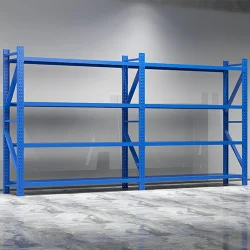Key features and considerations related to industrial shelving
2023-12-04
Industrial shelving refers to heavy-duty storage solutions designed to meet the robust demands of industrial environments, warehouses, manufacturing facilities, and other settings with high-capacity storage needs. These shelving systems are built to handle large, heavy items, providing efficient organization and accessibility. Here are key features and considerations related to industrial shelving:
Features of Industrial Shelving:
1. Heavy-Duty Construction:
- Industrial shelving is characterized by its robust construction, typically made from durable materials such as steel. This design ensures the ability to support heavy loads.
2. Bolted Connections:
- Many industrial shelving units use bolted connections for increased stability and load-bearing capacity. Bolted connections provide a secure and reliable structure.
3. Adjustable Shelves:
- Adjustable shelving allows for flexibility in organizing and storing items of various sizes. This adaptability is crucial in dynamic industrial environments.
4. High Load Capacity:
- Industrial shelving is designed to handle high load capacities, making it suitable for storing heavy equipment, tools, and materials.
5. Open or Closed Design:
- Industrial shelving units may have an open design (with wire mesh or steel grids) or closed design (with solid metal shelves). The choice depends on the type of items being stored and the desired visibility.
6. Modular Systems:
- Modular industrial shelving systems provide the flexibility to expand or reconfigure storage as needed. This modular design allows for scalability and adaptability.
7. Freestanding or Bolted to Walls/Floors:
- Industrial shelving units can be freestanding or bolted to walls and floors for added stability. Wall-mounted or floor-mounted options are common in spaces where seismic considerations or extra security are important.
8. Bin Storage:
- Some industrial shelving units are designed with bins, drawers, or dividers for efficient storage and organization of smaller items.
9. Cantilever Shelving:
- Cantilever industrial shelving is designed with horizontal arms extending from vertical columns, suitable for the storage of long, bulky items like pipes or lumber.
Considerations for Industrial Shelving:
1. Load Requirements:
- Determine the specific load requirements of the items to be stored on the shelves. Industrial shelving should have a weight capacity that exceeds the maximum load to ensure safety.
2. Shelf Spacing and Adjustability:
- Consider the spacing between shelves and whether they are adjustable to accommodate items of varying heights.
3. Accessibility:
- Evaluate how easily items can be accessed from the shelves. The design should allow for efficient retrieval and restocking.
4. Durability and Resistance:
- Industrial shelving should be resistant to wear, corrosion, and other environmental factors. Durable finishes and coatings help protect against damage over time.
5. Space Utilization:
- Optimize the use of available space in the industrial facility. Efficient shelving design should maximize storage capacity without hindering workflow.
6. Safety Features:
- Ensure that industrial shelving units comply with safety standards. This includes features such as safety clips, load capacity labels, and proper anchoring to prevent tipping.
7. Integration with Material Handling Equipment:
- Consider how the industrial shelving integrates with material handling equipment such as forklifts or pallet jacks. Adequate aisle space and accessibility are crucial for efficient operation.
8. Seismic Considerations:
- In areas prone to seismic activity, industrial shelving may need to meet specific safety standards and be anchored securely to withstand potential earthquakes.
Industrial shelving plays a crucial role in maintaining an organized and efficient storage system in industrial settings. The choice of shelving depends on the specific needs of the facility, the types of items to be stored, and the overall workflow requirements.



